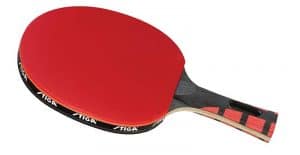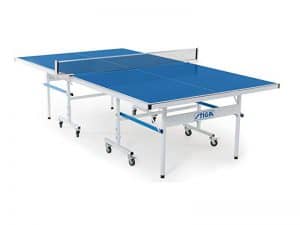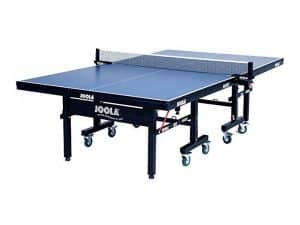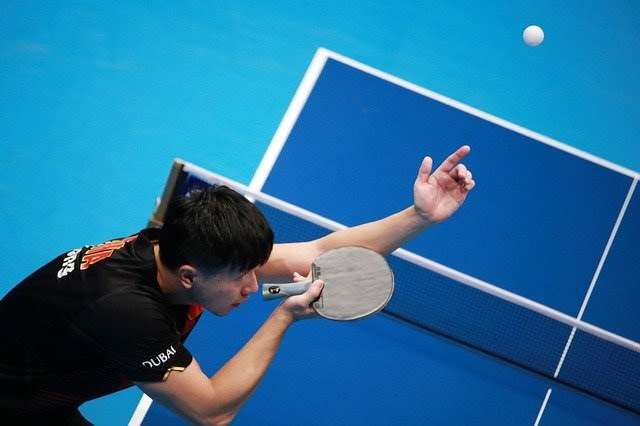Forehand Smash in Table Tennis: What Is It & How to Perform
- Alex Horscroft
- Last updated
Forehand smashes in table tennis are direct, fast, and some of the most difficult shots to return. They usually win the point outright or force your opponent to move away from the table, which puts you in a strong position. Learning how to smash well is key to being a successful player.
What Is the Main Goal of a Smash Stroke in Table Tennis?
A smash is one of the fastest shots in table tennis. Its goal is to finish the point. It excels above other shots because it prioritizes speed over spin. This makes it the ideal shot when the ball bounces high over the net.
How to Smash in Table Tennis: A Step-By-Step Guide
You strike down and forward using a flat racket angle to forehand smash in table tennis. This is what ensures that speed dominates over spin.
Step 1: Backswing
- Stand to the side of the ball and not too close to where it will bounce
- Right foot behind your left foot (for right-handers)
- Transfer your weight onto your back foot
- Rotate at the waist
- Raise your racket so that it is behind and above the ball
Step 2: Contact
- Transfer your weight onto your front foot
- Return your hips to the original position
- Strike the ball at roughly shoulder height
- Strike forward and downward
Step 3: Follow Through
- Continue with your racket motion
- Return to the ready position
Read More: How to Play Ping Pong
How to Develop Killer Power for Your Smash in Table Tennis
The key to a quality smash is power. And the way to maximize power is to store more potential energy.
You do this by properly transferring weight between your legs, twisting at the hips, and having an adequate stroke length. Many players put far too much emphasis on purely their swing, leaving their arm to do all the work. This will tire your arm out, and smashes are far inferior this way.
For my backswing, I twist at the hips around 90 degrees, and my racket is to the right of my body, as far away from the ball as possible. This gives me plenty of time to get my racket up to speed for a killer smash.
Other Ping Pong Smash Tips
Keep Your Wrist Fixed
As smashing doesn’t require much spin, engaging your wrist is unnecessary. Attempting to flick your wrist will hurt your smash.
Always Prioritize Forehand Smashes Over Backhand Smashes
There’s a reason you seldom see backhand smashes: They are inferior. Moreover, if the ball bounces high, you almost always have enough time to come around and play a forehand smash instead.
Just remember forehand smash > backhand smash.
Do Not Stand Too Close to the Ball
A common problem with beginners is standing too close to the ball. This causes them to lean away from the smash, stripping it of power.
Practice your distance management, and take a step back if in doubt. You can easily correct yourself if you’re too far away by taking a larger step forward when you smash.
Placement
While speed is one of the most important qualities of a smash, you should not neglect placement. A medium-speed, well-paced smash can easily outperform a fast but predictable smash.
Look at where your opponent is standing to see which ball position will give them the most trouble. You can also try faking a smash in one direction and hitting it to the opposite side instead.
Experiment With Height
There’s plenty of wiggle room regarding the height you contact the ball when smashing. A general rule of thumb is that shoulder-to-head height is the golden zone, but you do not have to conform to this standard.
Many players, especially the pros, strike the ball from above head height to devastating effect. You can also strike the ball below shoulder height, although I recommend not going too low as this is a much riskier stroke. Similarly, you can’t always take the ball at the top of the bounce as it may be too high.
Ultimately, you just need to strike the ball at a high position well above the net’s height.
Read More: 7 Ping Pong Drills to Improve Your Match Play
How Does a Smash Differ From a Drive?
Drives are probably the closest type of shot to a smash, but they still differ greatly.
Their similarity is the angle of contact with the ball. Both employ a direct stroke, imparting more speed than spin. This contrasts loops which use more of an indirect stroke as this shot focuses on brushing the ball to generate high levels of topspin.
However, forehand smashes tend to have a more flat angle than forehand drives. This is because they don’t necessarily need any topspin. After all, the ball bounces much higher than when you might use a drive.
Another difference is the speed. Smashes are the fastest shots in table tennis, and drives are usually more controlled.
How to Return a Smash
There are two primary ways to return a smash. The ideal method is quickly moving away from the table to play a lobbed return. Creating distance between yourself and the ball increases the time you have to react to the smash.
The second option is to hold your ground and play a block. Blocks have the advantage of requiring no wind up against smashes — the pace of the smash will do the work for you. However, you may not be able to position your racket quickly enough as you have less time to react.
Read More: Ping Pong Rules
Freelance writer. Table tennis enthusiast. Lover of all things online. When I’m not working on my loop game I’m probably binge-watching some fantasy show.
-
Alex Horscrofthttps://pingpongruler.com/author/alex-horscroft/
-
Alex Horscrofthttps://pingpongruler.com/author/alex-horscroft/
-
Alex Horscrofthttps://pingpongruler.com/author/alex-horscroft/
-
Alex Horscrofthttps://pingpongruler.com/author/alex-horscroft/
Popular Products
Join our email list for exclusive reviews & the latest Ping Pong News
Sign up to our newsletter and stay up-to-date with the latest news in the ping pong world, and be the first to read our new product reviews. We promise, no spam



















